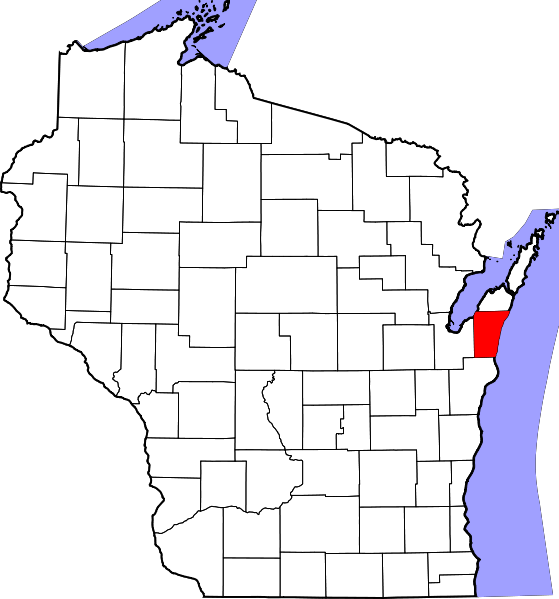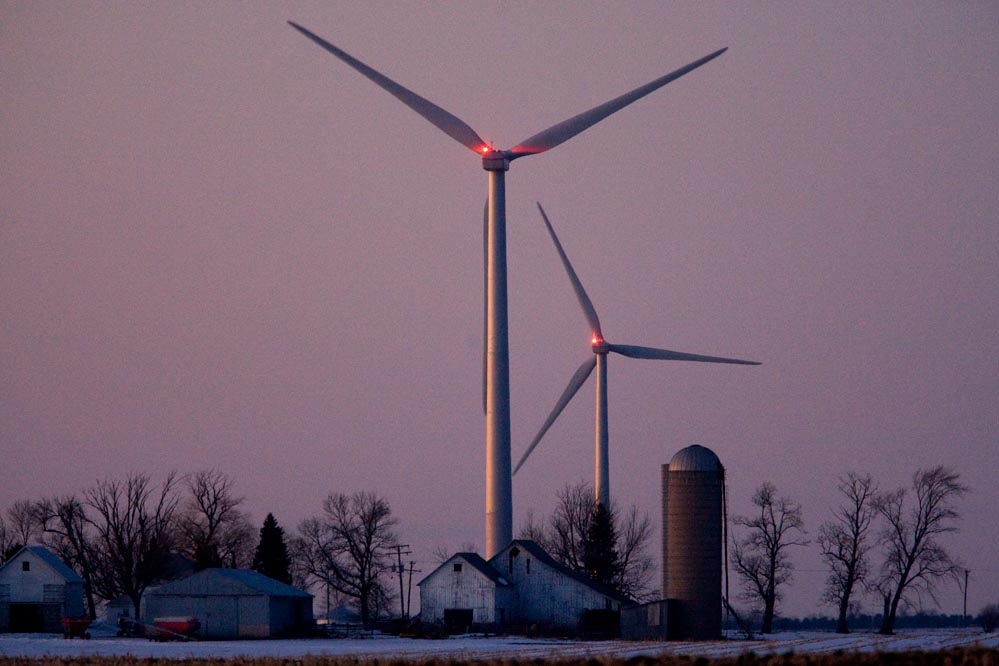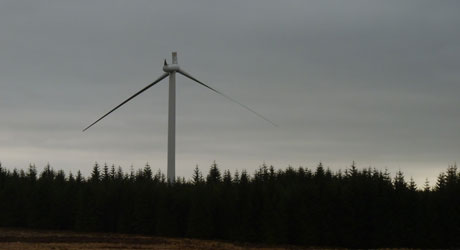Entries in Wind farm health effects (116)
4/23/10 What's all this noise about turbine noise? Whose word will you take? Someone who profits from putting turbines close to people's homes, or someone who is living with turbine noise every day?
Veteran noise engineer George Kamperman, Board Certified in Noise Control Engineering by the American Institute of Noise Control Engineering, wrote the following commentary after listening to a video clip (above) recorded by Larry Wunsch who lives near the Town of Byron in Fond du Lac County, Wisconsin. The closest turbine to his home is 1100 feet away. Wunsch is a firefighter and also happens to be a member of Wisconsin's Wind Siting Council, a fifteen member group who are now at work on creating guidelines for siting turbines in our state.
There is a must-see-and-hear 9 minute DVD by Larry Wunsch at his home in Byron, Wisconsin. Turn up the volume on your computer and listen either through earphones with good uniform base response, or listen from a full frequency range sound system.
You may be shocked by what you hear. The wind turbines make a roaring sound like a jet aircraft. The wind turbines radiate an excessive amount of low frequency energy, and this is the primary reason for our new approach (see How Loud Is Too Loud?) for determining wind turbine setback from dwellings.
Whenever you read about noise levels in the media, the decibel (dB) numbers are frequency weighted (dBA). The term is the “A-weighted” sound level. This frequency weighting discriminates against low frequency sounds, somewhat similar to human hearing response at low sound levels. The wind turbine industry has taken advantage of the phenomenon to show wind turbines produce sound levels no higher than the sound from “a gentle breeze rustling leaves of a tree” or “a small flowing stream” or “the refrigerator in your kitchen,” to cite just some of the examples argued by the wind turbine lobby. These examples are all plausible, and the industry probably has data to show it to be true.
What’s wrong with this picture? The wind industry examples definitely do not sound like the jet engine noise outside the home of Larry Wunsch! The problem is that wind turbines generate far more low frequency noise than high frequency noise where dBA is most sensitive. This is a dirty little secret the wind turbine industry has been hiding from the public.
To meet this challenge we have added (again, see How Loud Is Too Loud?) a requirement that both dBA and dBC noise data be published by the wind industry. The dBC frequency scale has a flat, uniform response throughout the audible range and thus is a better measure of any noise rich in low frequency sound. We propose wind turbine setbacks must meet both dBA and dBC limits.
I did an actual instrumentation analysis of the Larry Wunsch (YouTube) turbine noise recorded outside his front door. My measured noise characteristics agreed with the manufacturer’s claimed noise emission. Both sets of data show excessive low frequency noise outside the Wunsch home, and they show the dBC (broadband) turbine noise to be 13 dB higher than the dBA (high frequency) turbine noise.
Whenever dBC results exceed dBA results, it is a clear indication that low frequency noise not measured by dBA is in fact present. Noise engineers know this; the general public does not. The industry example of rustling leaves, above, would necessiate dBC one dB ldBA lower than dBA, which is clearly not the case outside Mr. Wunsch’s front door.
Behold the wind industry chicanery (deceit) when it pretends rustling leaves = whispering turbines. Rubbish!
Think of dBA and dBC as tone controls for listening to your favorite music. The treble control being the dBA, and the bass control being the dBC. A uniform random noise is often referred to as white noise. When you reproduce white noise and turn down the treble control (dBA) for reduced highs, and turn up the base control (dBC) for more “boom,” you end up with sound close to the wind turbine noise spectrum.
Or consider this illustration. All propellers produce what’s often called a “haystack” spectrum, where the top of the haystack (peak energy in the spectrum) is determined primarily by the diameter of the propeller circle (twice a blade radius). Think of the whining sound of small model airplanes. Next, think of the engine sound of an ultralight (single-person) aircraft. In this case the engine sound has a lower frequency than the remote-control model airplane. Next, think of the engine sound of a standard, single-engine plane. A Cessna or Piper Cub, let’s say. The engine sound is lower than the ultralight’s. Finally, imagine a B-36 bomber aircraft, where the engine pitch is lower yet.
The point being, as the propeller-sweep-circle-diameter increases, the top of the haystack pitch, or frequency, shifts downward.
Now, graduate to wind turbines. The biggest of them all. Huge propellers sweeping an enormous circle. Propellers so big that the peak of the haystack (peak sound energy) is in the 10 and 20 Hz range–and the peak is no longer audible. Even so, turbine propellers generate plenty of sound energy on the high frequency side, sliding down (increasing frequency) the high frequency side of the haystack, with the result that wind turbine sound spectrum continues to be very audible indeed.
The standard noise meter has had the same two, dBA and dBC, sound weightings since the instrument was invented (around 1940, I believe). The peak in the haystack spectrum for wind turbines is below the frequency range of both human hearing and the range of a standard sound-level meter (10 Hz to 20,000 Hz). In fact, the sound-level meter dBA response becomes increasingly less sensitive to sounds below 500 Hz (2 octaves above middle C on the piano), and has a uniform sensitivity at higher frequencies above 500 Hz. The dBC response, on the other hand, remains uniform thoughout all frequencies above 32 Hz (equivalent to the lowest note on a grand piano) to the upper limit of the instrument (which is 20,000 Hz). The low frequency roll-off below 32 Hz is standardized down to 10 Hz. Thus, this instrument is somewhat useful for near infrasound.
Wind turbines, by the way, do indeed produce infrasound, contrary to misleading statements by some acousticians. Since there is no ANSI (American National Standards Institute) or IEC (International Electrotechnical Commission) standard suitable for dealing with wind turbine infrasound, Rick James and I have sidestepped the issue for the time being in our “How To” guide. Rural America will be flooded with wind turbines of questionable value long before a consensus emerges among noise engineers on dealing with wind turbine infrasound. Individuals and communities who are understandably suffering from the infrasound and low frequency noise of turbines cannot wait for ANSI and the IEC to catch up with their dilemma. That’s why my colleague, Rick James, and I have jumped in and made do with the best off-the-shelf technology, instrumentation, and international noise standards currently available. When health and homes are under assault, as the research of Dr. Pierpont and many others makes clear they are, it would be unconscionable for someone with my training to look the other way.
Somehow we need to convince government... that wind turbines must be kept away from people’s homes. That many of these wind farms are in areas of marginal wind energy value makes this even more tragic.
-George Kamperman
4/1/10 TRIPLE FEATURE: Brown County Health department says wind turbine health effects need looking into AND Kewanee County Town of Carlton passes large wind moritorium No Foolin'! PSC will webcast AUDIO of today's 1:30 PM WSC Meeting!
PANEL ASKS FOR WIND TURBINE HEALTH STUDY
Source: Green Bay Press-Gazette, www.greenbaypressgazette.com
April 1, 2010
By Tony Walter,
The Brown County Health Department will look into the impact of wind turbines on human health.
Supervisor Patrick Evans, chairman of the Human Services committee, said he thinks the turbines proposed for southern Brown County pose a potential health danger and wants a study conducted.
“I feel there’s a health risk right now,” said Evans, who said he has done wind turbine consulting in Brazil and has health data compiled in European countries where the turbines have been built. “The only way that wind farms in southern Brown County can be stopped is through the health department.”
Chicago-based Invenergy LLC has proposed building 100 wind turbines in the area, with 54 of them in the town of Morrison. Opponents argue that the turbines would deflate land values and create health problems through noise and interference with the groundwater.
The Wisconsin Public Service Commission has authority to approve the turbines but hasn’t yet acted on the company’s request.
Evans said the health department study would be presented to the Board of Health, the Human Services committee and the County Board.
Health Department Director Judy Friederichs said she was planning to investigate the health danger anyway.
“We decided to be proactive after reading many of the comments,” Friederichs said. “But we really haven’t had a speaker on this at any of the state meetings. So we’re just starting to look into it.”

Carlton Wind moratorium approved: Residents seek to protect property rights
SOURCE Kewaunee County News, www.greenbaypressgazette.com
By Kurt Rentmeester,
March 31 2010
The Carlton Town Board approved a one-year moratorium on commercial wind turbines Monday, after more than 50 residents came to a public hearing to oppose the idea.
The board unanimously approved the measure on a 3-0 vote after Town Chairman Dave Hardtke said he received six or seven phone calls from residents who were contacted by the Ohio-based Element Energy to lease their property for wind generation.
Element Energy seeks to lease more than 18,000 acres for 111 commercial turbines as part of a wind farm between Kewaunee and Two Rivers. Wind turbines would be built on properties in the towns of West Kewaunee, Two Creeks, Mishicot and Two Rivers.
Property owners elsewhere have lost rights after signing lease agreements to site wind turbines on their land, according to Jeff Roberts, a town of Mishicot resident. Turbines have had an impact on cell phone and TV reception.
Carlton residents could have concerns if people in neighboring towns agree to the Element Energy proposal, Carlton Town Supervisor Steve Tadisch said. A state wind energy ordinance proposal may supersede state and county setback ordinances, he said.
Residents who sign leases may not realize they could lose their rights as property owners, said Jeff Roberts, a town of Mishicot resident. They also could lose their cell phone and TV reception, as well as have to live with the noise of turbines.
Gary Holly, a town of Carlton resident, learned Fond du Lac County residents lost some of their rights after talking to them last week.
He described one property owner who signed a waiver agreement to permit a wind turbine near his home as someone who “looked down. He was a beaten man.”
Lynn Holly, a business operator from the Tisch Mills area, said she learned about the issue two weeks ago. Property owners who sign contracts cannot discuss the issue with anyone, she said.
Until now, the state has had to go through local town zoning ordinances to site wind turbines. But the Wisconsin Legislature could give power companies the right to set those standards, according to Jerome Hlinak, a town of Mishicot resident. He is a member of Wisconsin Independent Citizens Opposed to Wind Turbine Sites (WIND COWS).
Town of Carlton residents need time to understand all the concerns associated with wind turbines, said Rick Phillips, a town resident.
While the Wisconsin Legislature has mandated exploration of renewable energy, he referred to the state’s efforts as a “knee-jerk reaction” that needs to be thought out.
Green energy grants that power companies are eligible for can be pulled, Hardtke said. Property owners then can lose money, too.
When people sign lease agreements for wind power, Becky Paplham said they should consider the long-term impact on residents with young families.
A state initiative on wind energy could be established to override any town or county ordinances. While Manitowoc County has a 1,000-foot zoning setback, the state could eliminate that.
Hlinak wants people to be concerned about changes in state law that could eliminate county, town and individual property rights.
“I feel we’re losing local control in our township with the state Public Service Commission and the Legislature stepping in,” Hardtke said. “They don’t care how it affects us here.”
SECOND FEATURE:

Sad because you can't make it to Public Service Commssion in Madison to attend the Wind Siting Council meetings as they to put together guidelines to site industrial scale wind turbines in our state?
 Be Happy! The PSC is webcasting the AUDIO proceedings live from the Flambeau River Room. The meeting begins at 1:30 PM and is open to the public. We'd much prefer video but we'll take the audio.
Be Happy! The PSC is webcasting the AUDIO proceedings live from the Flambeau River Room. The meeting begins at 1:30 PM and is open to the public. We'd much prefer video but we'll take the audio.
Topic of the day:-Developing guiding principles- Developer/owner responsibility
Public Service Commission Building
610 North Whitney Way, Madison, Wisconsin
Flambeau River Room
CLICK HERE to download a copy of the agenda
DO YOUR HOMEWORK! CLICK HERE to find out who is on the siting council
Wind Siting Council Meeting Live Broadcast
April 1, 2010 Beginning at 1:30 p.m.
Click Here to receive the LIVE AUDIO broadcast of the Wind Siting Council Meeting
The meeting begins at 1:30 but you may want to set up your connection earlier to make sure it's ready.
If the link doesn't work, go directly to the PSC homepage by CLICKING HERE and then clicking on the "PSC Live Broadcasts button" on the left.
|
FROM THE PSC WEBSITE about live broadcasts : PSC Live offers real-time broadcasts of the Commission's open meetings and public hearings. Commission meetings and public hearings held in the Amnicon Falls room include audio and video whereas events held in the third floor Flambeau River conference room will be audio only. |
| Note: There will be no broadcast if the event is not in session. We suggest that you tune in a few minutes before the session begins and close your media player when the session ends. |
3/31/10 No Foolin'! Second Wind Siting Council Meeting Tomorrow, April 1st, and "What's on the WSC Docket?"
 The next Wind Siting Council meeting is Thursday, April 1, 2010 at 1:30 pm
The next Wind Siting Council meeting is Thursday, April 1, 2010 at 1:30 pm
-Developing guiding principles- Developer/owner responsibility
Public Service Commission Building
610 North Whitney Way, Madison, Wisconsin
CLICK HERE to download a copy of the agenda
CLICK HERE to find out who is on the siting council
|
WHAT'S ON THE WIND SITING COUNCIL (WSC) DOCKET TODAY? Visit the docket by CLICKING HERE. The docket number to enter is 1-AC-231 Public comment from Brown County resident regarding setbacks being measured from property lines, March 30, 2010 Proper siting of industrial wind turbines is perhaps the most crucial and overlooked aspect of the wind power debate. The turbines proposed for the Ledge Wind project and other state projects are industrial machines - they have no business being placed near people's homes, workplaces, schools, or farms. It is also imperative that setbacks are measured from property lines, not simply from the center of buildings. People live not just in their homes, but also on their lands. A person's plans for their property should not be impeded because an industrial turbine is placed too close to their lotline. To limit the health consequences and maximize safety, industrial wind turbines should be sited, at a BARE minimum, no closer than 1 km from property lines. Even better would be 2 km. To do any less is reprehensible and irresponsible, and risks the health and safety of Wisconsin residents. I affirm that these comments are true and correct to the best of my knowledge and belief. Public comment from Brown County resident regarding WSC record keeping and wildlife concerns: March 31, 2010 I attended the first meeting of the Wind Siting Council and was concerned that no secretary of the proceedings had bee[n] selected. In a recent call to Deborah Erwin, I was happy to hear that minutes of the meeting would be taken and put on the PSC website. Also, efforts are being made to broadcast the meetings through the internet again on the PSC website. Thank you Deborah for arranging full coverage of the panel's discussions. I affirm that these comments are true and correct to the best of my knowledge and belief. |
3/25/10 DOUBLE FEATURE: Why 45 dbA is still too loud AND Anybody out there know how to measure this? AND The future of corporate hostile takeovers is green AND Extra Credit Assignment
“It’s been an ongoing disaster since they started to turn in 2008,” Marilyn said. “Sometimes (the sound) can be compared to a helicopter; it’s not something we are able to get used to.”
According to the couple, David began experiencing sleeplessness and fatigue, which caused them to move into an apartment.
“The turbines chased us from our home and we don’t want what happened to our family happening to yours,” Marilyn said.
Opponents say 45 decibels is still too loud
SOURCE: The Allegan County News, www.allegannews.com
By Daniel Vasko, Staff Writer,
March 24, 2010
More than 100 Monterey Township residents attended a presentation at Hopkins Middle School by the Citizens for Responsible Green Energy Saturday, March 20. The event was designed to explain the harmful effects of industrial wind turbines that are planned for Monterey Township.
The township has been considering modifying an ordinance regulating their placement since August 2009.
“The purpose of the presentation is to teach people about the turbines and how they will affect and impact their lives and quality of life,” Citizens for Responsible Green Energy member Laura Roys said.
According to another citizens group member, and Western Michigan University senior Nevin Cooper-Keels, township officials have been inefficient with drafting a safe and acceptable ordinance.
“The majority of the board on the planning commission have signed leases with the energy companies,” Cooper-Keels said. “My impression is that it has affected their judgment, and the board seems more concerned with an ordinance that will allow as many wind turbines as possible instead of protecting the community first.”
Township planning commission member Karon Knobloch, who owns an option for an easement with GE along with her husband, said in an interview there was no conflict of interest.
“It’s not a conflict of interest to write rules for (the companies); if it were to affect my home alone in some way then it would be,” Knobloch said. “Nobody wants to be awake all night because of noise; it’s our job to make it as safe and comfortable as possible.”
A major concern in drafting the wind energy ordinance has consistently been the sound levels produced by the wind turbines, and opponents have said the 45-decibel limit on all non-associated dwellings is too high.
Marilyn and David Peplinsky, who reside near wind turbines in Huron County traveled to Hopkins to speak about their experiences living near a wind farm.
“It’s been an ongoing disaster since they started to turn in 2008,” Marilyn said. “Sometimes (the sound) can be compared to a helicopter; it’s not something we are able to get used to.”
According to the couple, David began experiencing sleeplessness and fatigue, which caused them to move into an apartment.
“The turbines chased us from our home and we don’t want what happened to our family happening to yours,” Marilyn said.
Dr. Malcolm Swinbanks, who has worked for 23 years as an engineering consultant in the area of sound and vibration mitigation, said the Peplinskys live near turbines that have a 45-decibel limit—the same limit discussed by the Monterey Township planning commission.
Swinbanks also said wind turbines are known to produce low-frequency sounds that many people will find a disturbance. He also said low frequency sounds will penetrate structures and are amplified the more the background, or ambient, noise is shut out.
“It’s not something you get used to,” Swinbanks said. “(Some people) actually become more and more sensitive to it.”
He also said wind power was not as cost effective as people think, and that turbines have a greater “carbon footprint” and produce more pollution than other methods like nuclear power.
He said wind turbines each contain 20 gallons of gasoline and that the turbines run at only 20 percent efficiency.
The planning commission will meet April 12 to discuss further amendments to the ordinance.
SECOND FEATURE:
Amaranth Substation concerns remain
Orangeville Citizen, www.citizen.on.ca
March 25 2010
By Wes Keller,
A TransAlta Corp. executive said last Wednesday there are no plans to expand the Melancthon wind farm northward into Grey County and, in the meantime, the company would listen to anyone who can offer advice on how to deal with complaints of noise from the transformer substation in Amaranth.
Calgary-based Transalta is the successor to Canadian Hydro Developers Inc. (CHD), and now the owner of Canada’s two largest wind farms with a combined capacity of roughly 400 megawatts – at Melancthon/Amaranth and on Wolfe Island.
Jason Edworthy, Trans- Alta’s director of communications, told Melancthon council last Thursday that CHD is “a jewel in the crown (of TransAlta’s generation network).”
He said the township staff had “done a tremendous job” of accounting for the company’s taxes (segregating the amount to be paid by TransAlta to participating landowners), and said it was “exciting to see the areas” on which the township was spending its amenities payments.
He said the only change likely to be seen in the transition from CHD would be signage. (The sign at the CHD office is still the original.)
Mr. Edworthy did have one concern: the township’s reasoning in its call for a moratorium on wind turbine development.
Mayor Debbie Fawcett responded that “people are wary of health implications,” but Deputy Mayor Bill Hill referred to the reduction of assessments near the transformer substation, and said the township “didn’t want others to come in and potentially reduce all tax assessments in half.”
Mr. Edworthy said the “process (of reassessment) did not consider scientific evidence available publicly.”
In an interview earlier last Thursday, Mr. Edworthy said the CHD substation in Amaranth has had “the most investment in the TransAlta fleet.” He said the company has done everything it could measure to satisfy neighbouring concerns.
He said the substation is in compliance with Ministry of Environment guidelines and has sound barriers plus a new transformer. “We don’t know what to fix. We can’t measure any more. If anyone can tell us how to measure (the problem), we would follow through.”
The substation has two 100-megawatt transformers, adequate for the 200- MW capacity of the Melancthon/ Amaranth (Melancthon EcoEnergy Centre) wind farm.
TransAlta is a giant in the industry by comparison with CHD. It has roughly 80 plants in Canada, the U.S., including Hawaii, and in Australia. Why did it make its hostile takeover bid for CHD?
In a nutshell, it needed CHD’s “green energy” plants and future developments to reduce its carbon footprint.
“We have a lot of coalfired plants,” said Mr. Edworthy. “There’s lots of coal in Alberta. The company recognizes it’s got to go green going forward. CHD was a logical target – hostile at the start but friendly at the end.”
Even with the addition of CHD, TransAlta generation is heavily weighted with coal: 4,967 MW capacity with an added 271 MW under development. It has 893 MW hydro with 18 MW in development, 1,843 MW in gas-fired, 950 MW wind power with another 1,123 in development stages, 164 MW in geo-thermal, and 25 in biomass.
At the moment, 57% of capacity is in coal-fired, and 20% in natural gas. Between them, wind and hydro account for 22% of capacity. On location, 75% of capacity is in Canada, 22% in the U.S., and 3% in Australia.
At the time of the hostile bid last summer, CHD had announced plans to expand its operations by 100 megawatts annually in wind, hydroelectric and biomass as well as, possibly, solar.
Going green, TransAlta also needed the expertise of CHD personnel in wind, water, solar and biomass. So the entire staff complement was simply transferred to TransAlta.
Locally, Mr. Edworthy wasn’t entirely certain of the number stationed at the CHD operations centre, but did say there would likely be a dozen involved, which would be an increase from seven permanent a year or so ago.
3/23/10 TRIPLE FEATURE: What made the 150 blade snap off the turbine? AND What they are saying in DeKalb County, IL AND On the subject of Wind Turbine Syndrome, the doctor is IN
Wind farm shut down over safety fears after 150 ft turbine blade falls off
SOURCE: The Daily Record, www.dailyrecord.co.uk
March 23, 2010
Exclusive by Ben Spencer
Europe’s largest wind farm ground to a halt after a 150ft blade snapped off one of the turbines.
All 140 of the giant machines were immediately shut down at the £300million development near Glasgow until they could be inspected.
Engineers at Whitelee wind farm, which is run by ScottishPower Renewables, were trying to work out why the blade came crashing down.
They are looking into whether lightning could have struck the turbine or if it was caused by a mechanical problem.
It sheared off and hit the ground in the early hours of Friday morning in blustery conditions.
Automatic systems alerted operators in the control room to the damage and they immediately closed down the unit.
All 420 blades in the wind farm were being examined following the accident.
Last night, more than 50 turbines were expected to have been inspected and safely returned to operation.
The process is expected to be completed by Friday.
Whitelee wind farm’s visitor centre, which is managed by Glasgow Science Centre and had been due to reopen after the winter break yesterday, stayed shut.
German company Siemens, who supplied the turbines, are also understood to be investigating.
The 360ft turbines are so massive that engineers have been able to climb inside them to try to detect the problem.
Over the weekend, the site at Eaglesham Moor, 13 miles from Glasgow city centre, was cordoned off to keep visitors away. Raymond Toms, 45, a teacher from East Kilbride, spotted the broken turbine as he cycled past on Sunday.
He said: “I was out for a bike ride and I saw one of the massive blades had broken clean off. It was quite unnerving really.
“You can walk right up to these things normally and touch them.
“The public have access to the network of pathways nearby.
“I have grave concerns over the safety of the public, who can walk right up to the turbines.
“It’s worrying that if one of these could fall off then perhaps another one could.
“It’s made me think about going too close, that’s for sure. It’s just lucky this took place at night, when nobody was around.”
Keith Anderson, managing director of ScottishPower Renewables, said: “This type of incident is exceptionally rare and highly unusual.
“However, the safety of our people and the public is our first priority.
“While the investigation into the cause of the incident is ongoing, our engineers continue to conduct an internal and external examination of all turbine blades at the wind farm”.
A spokesman for the firm added: “Investigations are ongoing, and a number of possibilities including mechanical failure and lightning strike are being considered.
“Operators in the 24-hour control room immediately closed the turbine down.
“This is a highly unusual situation. I’ve not heard of this kind of incident happening in 30 years.”
GREEN ENERGY BLUEPRINT
Whitelee was officially switched on in May 2009 by First Minister Alex Salmond.
Each turbine at Whitelee, which started producing electricity in January 2008, stands 360ft high.
The wind farm has 140 turbines that can generate 322 megawatts of electricity, enough to power 180,000 homes.
ScottishPower Renewables have been given permission to add 36 turbines to the site, allowing the wind farm to power 250,000 homes and create up to 300 jobs.
Last week, it was revealed that community groups in East Renfrewshire are to benefit from a fund set up from the development of Whitelee.
The fund will deliver about £140,000 a year for the next 25 years to the area’s council for local groups.

SOURCE: A Photo Blog :: Chicago Photojournalist Alex Garcia
Most people when asked are in favor of wind energy. Green. No foreign oil. No spent fuel rods. Cool-looking turbines.
But when a reporter and I went out to DeKalb County to talk to residents embroiled in a lawsuit surrounding a wind farm installed in an otherwise tranquil setting, we heard quite an earful.
Residents pitted against each other, noise, shadow flicker, lost sleep, stress, dead animals, lower real estate values, lost sightlines. It was a long list of complaints.
Although many people wrote off their grievances as little more than NIMBY, you do have to wonder whether 1400 feet is the sufficient amount of distance that a turbine should be from the foundation of a home.
Landowners who allowed the wind turbines on their properties are to be paid $9000 a year, per turbine, for the privilege. Some had a few. In this economy, I can see it from their perspective too. In this case, however you look at it, the wind blew up a storm.
SECOND FEATURE:
Letter from Dr. Nina Pierpont against siting wind turbines near home
SOURCE: Wind Concerns, Ontario
I am told that wind developers are proposing to build industrial-scale wind turbines as close as 270 meters [less than 900 feet] from people’s homes.
This is a reckless and violent act. The evidence for turbines producing substantial low frequency noise and, worse, infrasound, is no longer in dispute.
The clinical evidence is unambiguous that low frequency noise and infrasound profoundly disturb the body’s organs of balance, motion, and position sense.
The case studies performed by me and other medical doctors have demonstrated unequivocally that people living within 2 km of turbines are made seriously ill, often to the point of abandoning their homes.
There is no doubt among otolaryngologists and neuro-otologists who have studied the evidence that wind turbine low frequency noise and infrasound are seriously disrupting the body’s vestibular organs, resulting in the constellation of illness I have called Wind Turbine Syndrome.
The cure for Wind Turbine Syndrome is simple: Move away from the turbines or shut off the turbines.
The prevention of Wind Turbine Syndrome is even simpler: Don’t build these low frequency/infrasound-generating machines within 2 km of people’s homes.
Governments and corporations who violate this principle are guilty of gross clinical harm. Such governments and corporations should be taken before whatever level of court is necessary to stop this outrage.
I realize these are strong words. They are carefully chosen. They are strong because governments and the wind industry stubbornly—I would add, criminally—refuse to acknowledge that they are deliberately and aggressively harming people. This must stop. The evidence is overwhelming. I repeat, this must stop.
Nina Pierpont, MD, PhD
Fellow of the American Academy of Pediatrics
Former Clinical Assistant Professor of Pediatrics, College of Physicians & Surgeons, Columbia University, New York

